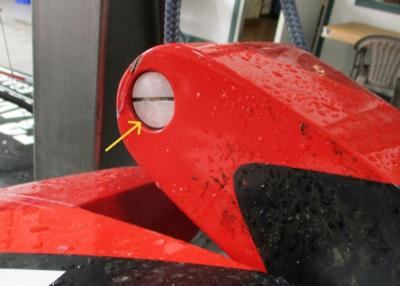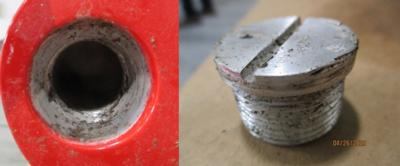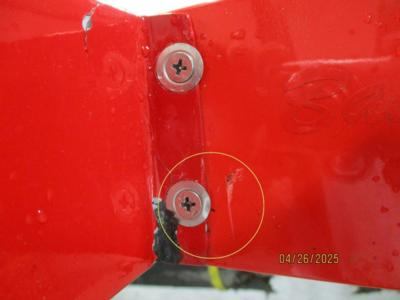Airplane... “Porpoised” Twice, Pitched “Straight Up,” Rolled 90° To The Left And Descended To Ground Impact
With little credible detail coming from proper sources up to this point, an air of mystery surrounded the recent and tragic accident that befell airshow pilot Rob Holland... an event that shocked the aviation community and has reverberated each day since, among pilots and fans who couldn't quite believe such a thing could happen to a pilot with his experience and skillset.

But it did... and there now seems to be a mechanical element as a prime suspect -- not an unexpected turn of events, and one that strikes close to home for those of us who have lost loved ones to critical mechanical failures... -- E-I-C Note: Jim Campbell
NTSB's preliminary narrative states:
On April 24, 2025, about 1135 eastern daylight time, an MX Aircraft Tech PTY LTD MXS airplane, N530RH, was substantially damaged when it was involved in an accident at Langley Air Force Base (LFI), Hampton, Virginia. The pilot was fatally injured. The airplane was operated as a Title 14 Code of Federal Regulations Part 91 personal flight.
The flight originated from Smyrna Airport (MQY), Smyrna, Tennessee, and was destined for LFI, where the pilot intended to perform an aerobatic routine during an upcoming airshow. Multiple witnesses stated that they observed the airplane on approach to land on runway 08 at LFI. The airplane made a normal approach to the runway and when it was over the end of the runway, it leveled off about 50 ft above the runway and flew straight down the runway for several hundred feet. The airplane then “porpoised” twice, pitched “straight up,” rolled 90° to the left and descended to ground impact.

The single-seat aerobatic airplane, serial number MXS-001, was issued a special airworthiness certificate in the experimental category for the purpose of exhibition and air racing by the Federal Aviation Administration (FAA) on July 26, 2019. The pilot collaborated with the manufacturer to modify the airplane to his specifications, which included an access hole on the left and right elevator to insert counterweights to adjust elevator feel depending on the aerobatic routine performed. An aluminum threaded plug was used to access the counterweight hole.
The airplane came to rest on a heading of 150° in a grass ditch about 100 ft from the left side of runway 08 and 500 ft beyond the approach threshold. All major components of the airplane were accounted for at the accident site. The left elevator counterweight plug was not installed and was located about 10 ft behind the wreckage in the grass. Dirt consistent with that found in the vicinity of the accident site was identified on the elevator, as well as in the counterbore and threaded area where the counterweight plug would have been installed. The counterweight plug threads were intact and also contained similar dirt contamination consistent with that found on the elevator. Additionally, about half of the circumference of the left elevator counterweight plug displayed gouging and there was evidence of paint transfer.

The horizontal stabilizer structure adjacent to the elevator position where the counterweight plug would have been installed displayed dents and paint scrapes consistent with contact with the counterweight plug.
The left wing remained attached to the fuselage. The left aileron was intact, though the outer section of the aileron was fractured at its hinge point. The right wing remained attached to the fuselage. The center fuel tank was breached, and both the left and right fuel tanks were empty. The empennage was intact and the left elevator was fractured off the outer hinge at the upper bracket that connected to the fuselage. The elevator trim tab was found in the full up (nose down) position. The right elevator was intact and remained attached. The rudder was intact and the bottom of the rudder was crushed. The cockpit and instrument panel displayed impact-related damage, and several instruments were dislodged and located around the cockpit. The throttle grip was fractured off the side of the cockpit. The control column was fractured off the bottom hinge point. The canopy was fractured into several pieces that were located around the main wreckage. Flight control continuity was traced from the cockpit
control stick to all flight control surfaces. The right aileron torque tube was fractured consistent with impact.

The propeller hub remained attached to the engine crankshaft. Two of the three propeller blades were broken off at the hub. The remaining propeller blade exhibited minor scaring. The rear part of the oil sump/air plenum was fractured. The exhaust and intake tubes were crushed upwards. The top two engine mounts were separated from the engine case. The top sparkplugs were removed and appeared normal as compared to the Champion Aviation chart AV-27. When the engine crankshaft was rotated by hand, thumb compression was attained at all the cylinders and engine drivetrain continuity was confirmed throughout.
The airplane was equipped with an MGL Avionics primary flight display which was retained for data download. The remainder of the wreckage was also retained for further examination. The airplane’s most recent condition inspection was completed on March 3, 2025, at a total airframe time of 1,062 hours.
The pilot held an airline transport pilot certificate with ratings for airplane single-engine land, airplane single-engine sea, airplane multiengine land, and gliders. He also held flight instructor and ground instructor certificates. The pilot reported 15,387 hours of total flight experience on his most recent application for an FAA second-class medical certificate, which was issued on March 5, 2025.
 ANN's Daily Aero-Linx (04.30.25)
ANN's Daily Aero-Linx (04.30.25) ANN FAQ: Turn On Post Notifications
ANN FAQ: Turn On Post Notifications Classic Aero-TV: Agile Aeros Jeff Greason--Disruptive Aerospace Innovations
Classic Aero-TV: Agile Aeros Jeff Greason--Disruptive Aerospace Innovations Aero-News: Quote of the Day (04.30.25)
Aero-News: Quote of the Day (04.30.25) ANN's Daily Aero-Term (04.30.25): Expedite
ANN's Daily Aero-Term (04.30.25): Expedite






